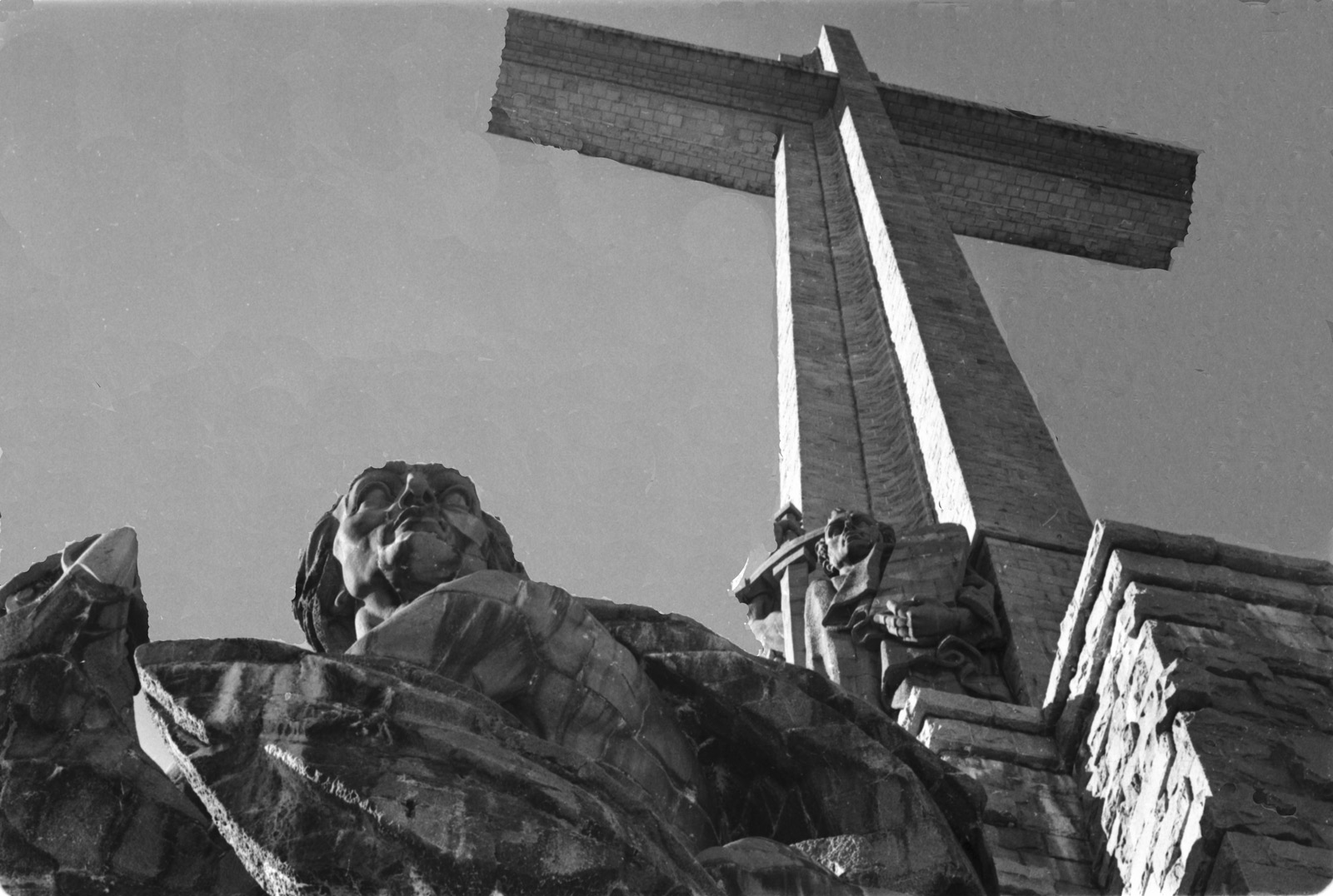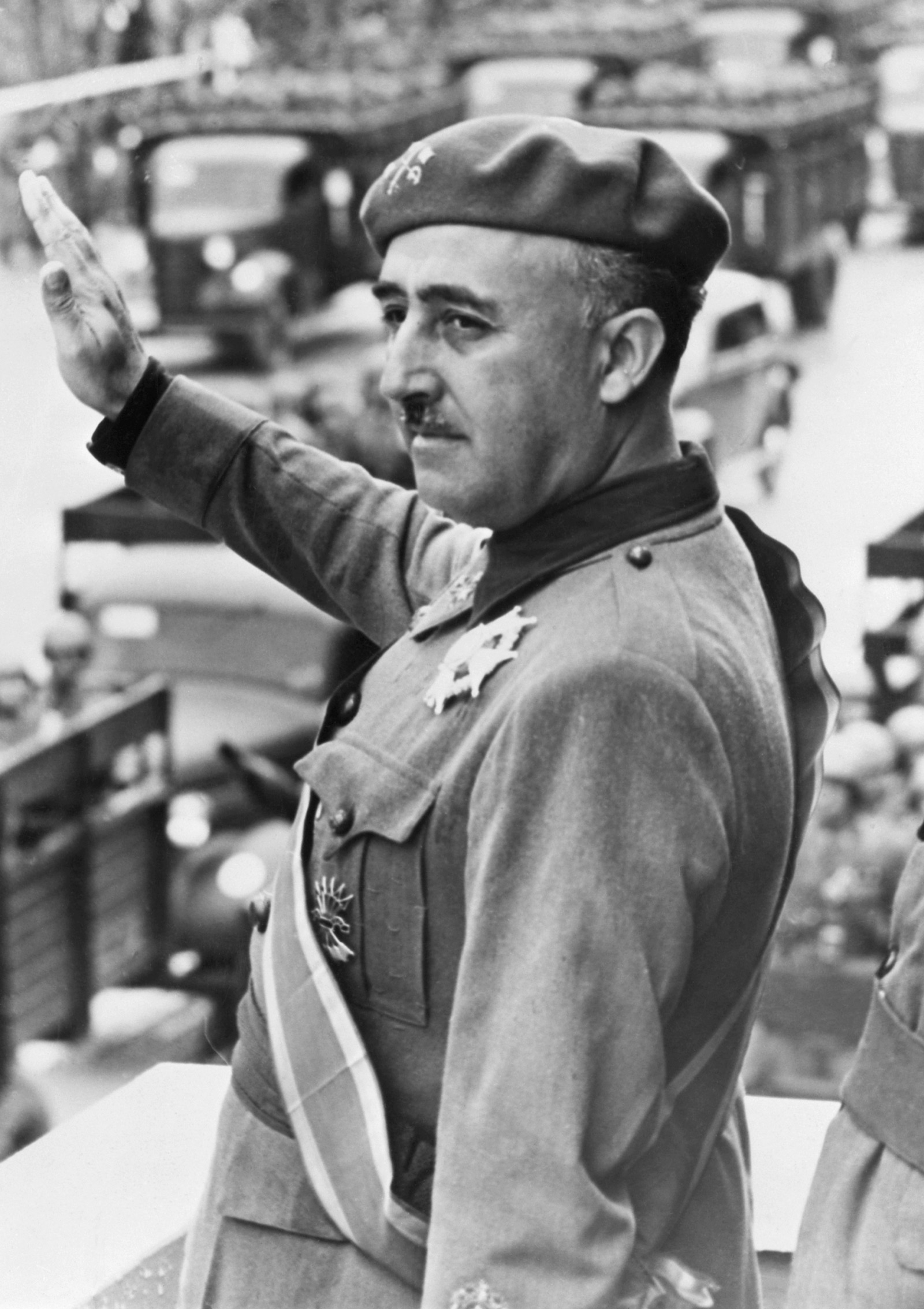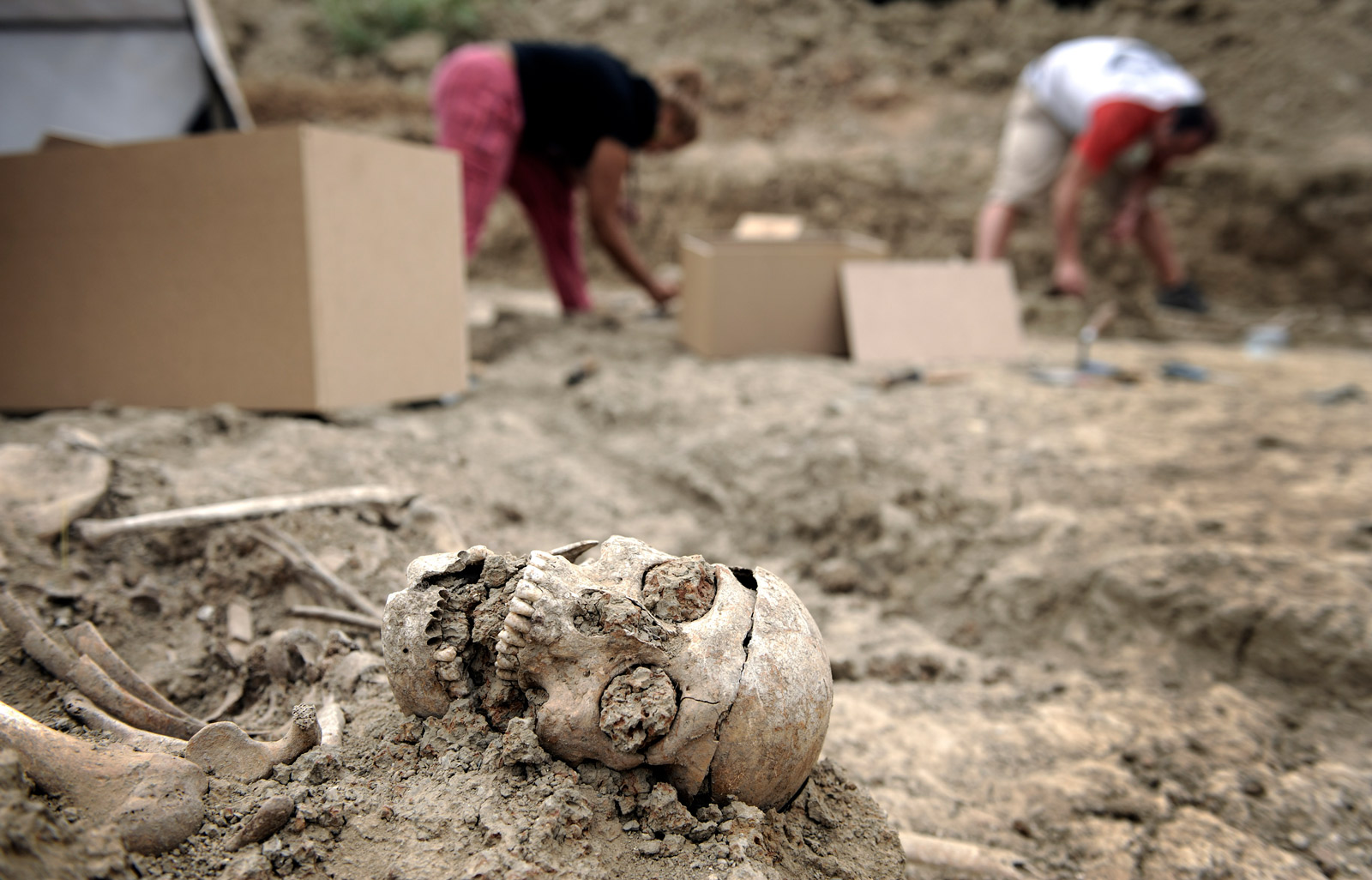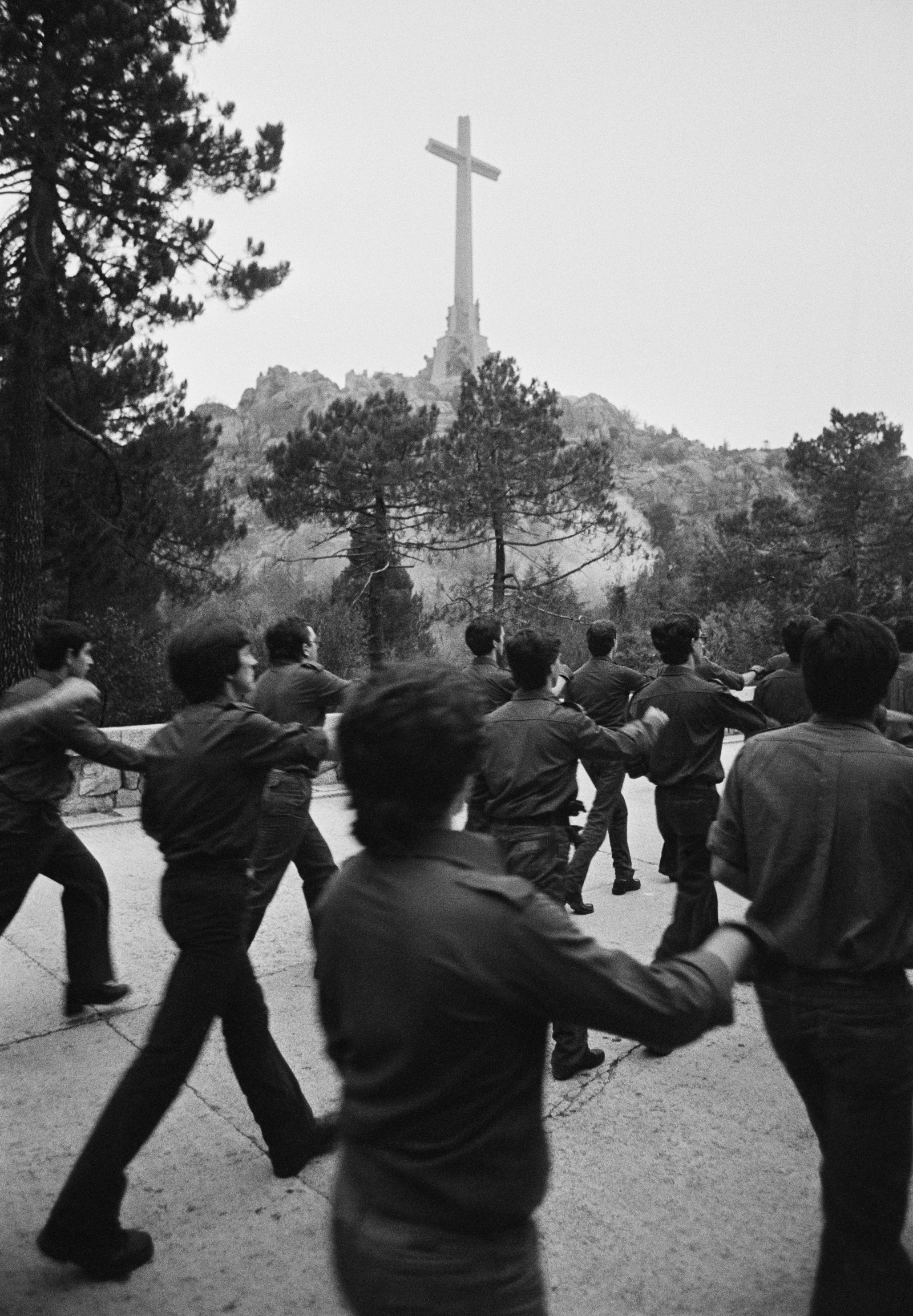Few dictators have enjoyed the reverential afterlife of Generalissimo Francisco Franco, who ruled Spain with an iron fist from the end of the Spanish Civil War in 1939 until his death in 1975. Franco’s resting place, El Valle de los Caídos (or the Valley of the Fallen), on the outskirts of Madrid, is Spain’s grandest public monument, completed in 1959 to mark the twentieth anniversary of the end of the civil war. It features the world’s tallest memorial cross and an underground basilica consecrated by Pope John XXIII in 1960, which is one of the largest in all Christendom. A grand esplanade offers a view of the majestic Sierra de Guadarrama mountains.
Franco’s mausoleum is located in the basilica’s main crypt. The small community of Benedictine monks that has made El Valle its home offers daily prayers for Franco’s soul. Sunday mass includes a boys’ choir singing Gregorian chants. Every November 20, on the anniversary of his death, hundreds of Franco sympathizers make a pilgrimage to the monument to pay tribute to “El Caudillo” and the legacy of his Falangist regime.
But if Spain’s new Socialist prime minister, Pedro Sánchez, has his way, El Valle will soon receive a radical makeover. In June, Sánchez announced his intention to move Franco’s remains from El Valle and transform the site from a shrine to Francoism to a “memorial for the victims of fascism.” Explaining his decision, Sánchez insisted: “Something that is unimaginable in Germany and Italy, countries that also suffered fascist dictatorships, should also be unimaginable in our country.”
If implemented, Sánchez’s proposal for El Valle would be the biggest step yet in Spain’s long and agonizing process of coming to terms with the horrific legacy of the civil war and the Franco dictatorship. As chronicled by the British historian Paul Preston in The Spanish Holocaust, the human toll of the three-year war (1936–1939), that was set in motion by the attack of Franco’s Nationalist forces on the popularly-elected Second Republic, is staggering: close to one million people died. Included in this tally are some 200,000 soldiers who died on the battlefield; a further 200,000 men and women who were executed during the war (the vast majority of them by Franco’s forces, and the rest victims, including some 4,000 clergy, of the so-called red terror, or reprisal killings, carried out by anarchist, communist, and socialist groups); and an unknown number of civilians killed by Franco’s bombing of Spanish cities and villages.
The postwar years were hardly less horrific. As part of a policy of “cleansing” intended to eradicate all opposition to Franco, some 20,000 Republicans were executed immediately after the war, and an additional 370,000 were forced into concentration camps, where many died of starvation and malnutrition. Half a million people were forced into exile. Only recently, in 2011, did Spaniards learn that the Franco regime had overseen the theft of some 300,000 babies from “morally-deficient” parents and their sale to “approved” families. Orchestrated by a sinister network of priests, nuns, doctors, and public officials, the trafficking of babies began in 1939, to punish “red” parents, though it later grew into a lucrative, profit-making enterprise.
Unlike other postwar democratic transitions, there was no “transitional justice” in Spain as part of the dismantling of the Franco regime. There was no criminal prosecution of the Franco regime akin to the trial that handed the death penalty to top Nazi officials at the Nuremberg Tribunal, or the military trials that succeeded in giving lifetime prison sentences to the architects of Argentina’s Dirty War. Nor did Spain see fit to conduct a process of lustration to purge anyone associated with the authoritarian regime, as was undertaken in the case of the Salazar dictatorship in neighboring Portugal, or to organize a Truth and Reconciliation Commission like South Africa’s, which chronicled the sins of apartheid. Unsurprisingly, Spain has been cited repeatedly by the United Nations for violating international norms of how nations are expected to deal with large-scale human rights violations and for not doing enough for the victims of the civil war.
Militating against transitional justice in Spain was the very nature of the democratic transition. Franco’s enemies never managed to topple him (he died a peaceful death in his own bed), and this allowed the authoritarian regime to reinvent itself as a democracy following the dictator’s death. A less apparent factor is the culture of political consensus that came with this regime shift. One of the transition’s anchoring agreements was the “pact of forgetting.” Broadly supported by a public still traumatized by the memory of civil war and eager to move on with democracy, this political agreement committed politicians from across the ideological spectrum to avoid any talk about who bore responsibility for the conflict and proscribed any public policy that would rekindle its memory. This was all for the sake of allowing democracy to consolidate as non-confrontationally as possible.
Advertisement
Even to broach the topics of reparations, apologies, and commemorations was deemed a violation of the pact to forget. The only reason that justified discussion of the civil war was to stress the need not to talk about it. In 1986, on the fiftieth anniversary of the start of the war, the only official act marking the occasion was a statement by Prime Minister Felipe González that noted: “the civil war’s fratricidal character made it unsuitable for commemoration.” It added: “the civil war is history and no longer part of the reality of the country.” The fact that this statement came from the first left-wing head of government since the Republican era added to its significance.
The voluntary vow of silence could only hold for so long, however. In the early 2000s, groups such as the Association of Ex-prisoners of Franco and the Association for the Recovery of Historical Memory began agitating for change, arguing that Spanish democracy no longer needed to be protected by political amnesia. These groups were emboldened by Spain’s ill-fated attempt to prosecute the Chilean strongman Augusto Pinochet on crimes against humanity, which had the unintentional effect of reminding the public about the unfinished business of the Spanish transition. The pressure to revisit the past culminated in the 2007 Law of Historical Memory. Among other things, this landmark legislation, enacted by José Luis Rodríguez Zapatero’s Socialist administration, declared the Franco regime “illegitimate” and offered reparations to victims of atrocities during the civil war and under the ensuing dictatorship.
But this law drew the line at altering monuments of “historical significance,” such as El Valle. That decision reflected the attitude of the public at the time, when a majority opposed tinkering with the Franco memorial in any major way. This hesitation was a reflection of Spaniards’ considerable lingering ambivalence about Franco. In 2008, the last time the Spanish government polled the nation on public attitudes toward Franco, 58 percent felt that Franco had done “good and bad things.” But polls now suggest that most Spaniards believe Franco should not be honored at El Valle.
There is a compelling case that the Sánchez administration’s proposal for El Valle would go a long way toward reconciling the still divisive legacy of the civil war. From its origins, to its myths, to its architecture, El Valle is steeped in infamy. Construction of the monument began in 1940 to mark Franco’s victory in what was referred to as “The War of Salvation.” The monument was thus intended to celebrate the most enduring myth of the Franco regime: that it had saved Spain from the chaos and violence of the Republican years. To convey a sentiment of national gratitude, Franco was determined not to use public funds to build El Valle, relying instead on a variety of funding schemes, including a special national lottery.
Initial estimates suggested that El Valle would take only a year to build. But the economic hardship of the postwar years—conditions exacerbated by the Western economic boycott imposed on the Franco regime until at least 1959, to say nothing of the difficulty of executing the design of the monument by carving out the basilica from the rocky terrain—pushed the schedule for the building’s completion to nearly twenty years. To speed up construction, the Franco regime resorted between 1942 and 1950 to forcing Republican prisoners to work at the site. These prisoners were promised shorter sentences in exchange for their labor. In 2005, the Madrid newspaper ABC estimated that 20,000 Republican prisoners worked at the monument.
By the time of its consecration in 1960, the monument’s symbolism had radically shifted: from a monument to Franco’s victory in the civil war to a memorial for national reconciliation. This change of presentation was designed to appeal to the international community, including the United States, which by then was warming up to Franco’s conception of himself as the West’s leading anti-communist warrior. To achieve its new purpose, the remains of thousands of civil war victims (from both sides of the conflict) were hastily buried there, turning the site into one of the world’s largest mass graves.
As of today, some 33,833 bodies are buried at El Valle, many of them placed there without the knowledge or consent of their relatives. For years, many relatives who did know that their family members were interred at El Valle have been fighting to remove their remains from the site. Only recently have these relatives met with some success. In 2016, a court authorized the exhumation of two brothers, Manuel and Antonio Ramiro Lapeña Altabás. After Franco’s army executed them in 1936, their remains were buried in a mass grave in their hometown of Calatayud in northeastern Spain; years later, their remains were transported to El Valle in time for the monument’s opening in 1959.
Advertisement
Save for the remains of those Republicans buried at El Valle, little else about the memorial hints at national reconciliation. Variously described as fascist and neo-classical, the monument’s aesthetics—the work of architects Pedro Muguruza and Diego Méndez and the sculptor Juan de Ávalos—pay homage to Spanish imperialism, especially to the nearby Royal Monastery of El Escorial, built by Philip II in the sixteenth century. That’s no accident: arguably, no other period in Spanish history conveys the global power of the Spanish Crown and the ecclesiastical predominance of Catholicism in Spain than Philip II’s reign. More than anything, though, El Valle glorifies the heroes and martyrs of Franco’s Catholic-nationalist crusade. As if to underscore this point, the only other individual grave besides Franco’s that is marked at El Valle belongs to José Antonio Primo de Rivera, the founder of the Falange (the sole party permitted in Franco’s Spain). Rivera was assassinated in 1936, as part of a rash of political assassinations that precipitated the civil war.
Given its infamy, it is not surprising that El Valle occupies a rather strange place in the national consciousness. Many Spanish liberals deem El Valle not only a national embarrassment, but also an unredeemable artifice unworthy of conversion into a civil war memorial. Terrorist groups would love to blow the monument to pieces—several have actually tried, planting bombs inside it (in 1999, the First of October Antifascist Revolutionary Groups, or GRAPO, detonated a bomb inside the crypt that destroyed several pews; a few years later, in 2005, the Basque separatist organization ETA took credit for bombing a bridge in one of El Valle’s gardens). Most Spaniards simply go about their business as if the monument did not exist. The majority of annual visitors to El Valle, numbering some 240,000, are foreigners. Indeed, the only significant group of Spaniards who visit El Valle is the tiny minority that still reveres Franco. The prospect that anything might change at El Valle has sent this group into the streets of Madrid, chanting El Valle no se toca (don’t touch the Valley).
The Sánchez administration’s proposal for El Valle has not taken place in a vacuum; there are clearly potential political benefits at stake. Sánchez is hoping that tackling head-on the treacherous politics of the memory of the civil war—something of a third rail in Spanish politics—will ensure that his unorthodox rise to power last June through a no-confidence vote against the Mariano Rajoy administration will not prove a footnote in Spanish history. Indeed, upending the status quo at El Valle is part of a playbook Sánchez has adopted to ensure his re-election when the next general election is held, which is widely expected to be 2020.
First and foremost, Sánchez may hope to fire up his left-wing base in order to bolster the fragile governing coalition that brought him to power, comprising Sánchez’s own Socialist Party, the populist Podemos (We Can), and the leading nationalist parties from Catalonia and the Basque Country. Ideologically speaking, this was the same coalition that bore the brunt of Franco’s repression. Transforming El Valle has been a priority for the Socialists since enacting the Law of Historical Memory, but the Rajoy administration, in power from 2011 to 2018, stymied the main initiative: a 2011 report from an expert commission that envisioned the removal of Franco’s mausoleum from El Valle as a first step in its conversion was endorsed by a non-binding vote in the Spanish Parliament in 2017—but Rajoy ignored it.
Sánchez is also trying to provoke the opposition, particularly the conservative Popular Party, or PP, into defending Franco and the legacy of his dictatorial regime. This, in turn, would allow Sánchez to paint the PP, and the Spanish right as a whole, as relics of Francoism. So far, conservatives are playing directly into Sánchez’s hands by accusing Sánchez of reopening old wounds best left undisturbed. “I would not spend one euro on exhuming Franco,” said Pablo Casado, the newly appointed PP leader. This is the same argument that conservatives used to stop the Law of Historical Memory. It did not work then (though it did succeed in watering down the legislation), and it is unlikely to stop Franco’s exhumation now. Public opinion is in favor of it, and the Spanish Conference of Bishops, once a fierce opponent of the memory law, has declared itself neutral on the issue.
At the same time, Sánchez is hoping that the exhumation of the old dictator will send an unambiguous message to the restive region of Catalonia, whose struggles for independence last October tested the resilience of Spanish democracy, that Spain has, once and for all, freed itself from the Francoist past. Catalan separatists have longed justified their desire to break way from Spain with the claim that the Spanish state is too beholden to the past. Indeed, it is hard to think of a more emphatic gesture that Madrid could make to upend this view of Spain than getting Franco’s remains out of El Valle.
Finally, Sánchez hopes to gain political capital by working to unify Spain. Because of the crisis in Catalonia, national unity has emerged as the most critical issue in Spanish politics, far exceeding public concern about the economy. National unity is the main driver behind the rise of Ciudadanos, or Citizens, a center-right party that hails from Catalonia but ardently opposes Catalan independence. One recent poll suggests that this new political force could defeat both the Socialist Party and the Popular Party in the next general election, largely because of its insistent message of national unity.
To be sure, Sánchez’s mission is not without political peril, particularly if he overplays his hand. Perhaps mindful of this, his proposals make no move that would truly shatter the politics of forgetting—such as calling for the prosecution of former Franco officials (virtually all of them are of very advanced age today)—which would require revoking the amnesty law passed by the Spanish Parliament in 1977, or convening a truth commission to assign responsibility for the crimes of the civil war. Either course of action would certainly test the capacity of Spaniards to tolerate so painful an exhumation of the nation’s past, especially because there remains no consensus in Spain on who is to blame for the civil war.
There’s also a risk that Sánchez could stir a host of other resentments. El Valle is a religious site, which means that the Catholic Church will have a say in what happens to the monument. The Benedictine abbot who presides over the memorial has traditionally opposed any change to the monument. And what to do with Rivera’s remains is still an awkward matter; some feel that they belong in El Valle because, unlike Franco, Rivera was actually killed in the civil-war hostilities. And finally, will the name of “El Valle de los Caídos” itself be changed, since it is so closely tied to the phrase that is used to reverence the dead on Franco’s side: “Caídos por Dios y por España” (Fallen for God and for Spain)?
Whether those who are loyal to the losing side of the Spanish Civil War will ever accept El Valle as an appropriate site to honor those who gave their lives for democracy and freedom is an open question. Those who supported the Republic paid the highest price—yet today, they are the war’s most overlooked victims.






